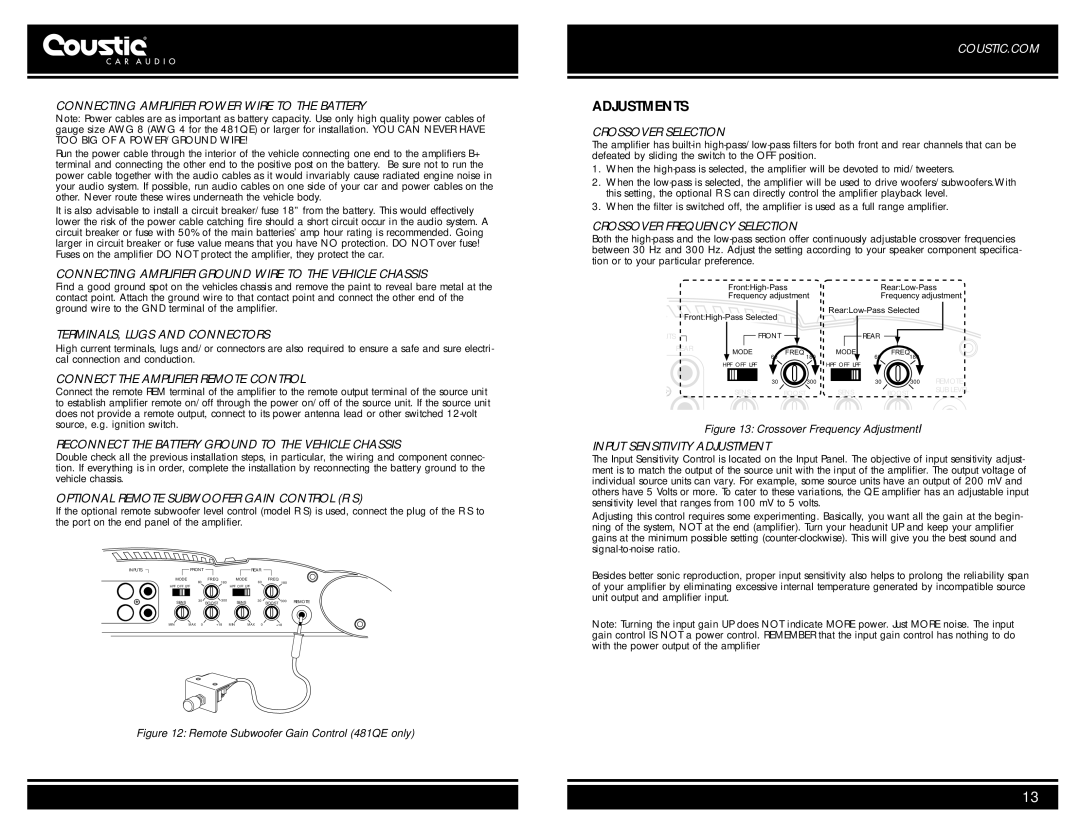
CONNECTING AMPLIFIER POWER WIRE TO THE BATTERY
Note: Power cables are as important as battery capacity. Use only high quality power cables of gauge size AWG 8 (AWG 4 for the 481QE) or larger for installation. YOU CAN NEVER HAVE TOO BIG OF A POWER/GROUND WIRE!
Run the power cable through the interior of the vehicle connecting one end to the amplifiers B+ terminal and connecting the other end to the positive post on the battery. Be sure not to run the power cable together with the audio cables as it would invariably cause radiated engine noise in your audio system. If possible, run audio cables on one side of your car and power cables on the other. Never route these wires underneath the vehicle body.
It is also advisable to install a circuit breaker/fuse 18” from the battery. This would effectively lower the risk of the power cable catching fire should a short circuit occur in the audio system. A circuit breaker or fuse with 50% of the main batteries’ amp hour rating is recommended. Going larger in circuit breaker or fuse value means that you have NO protection. DO NOT over fuse! Fuses on the amplifier DO NOT protect the amplifier, they protect the car.
CONNECTING AMPLIFIER GROUND WIRE TO THE VEHICLE CHASSIS
Find a good ground spot on the vehicles chassis and remove the paint to reveal bare metal at the contact point. Attach the ground wire to that contact point and connect the other end of the ground wire to the GND terminal of the amplifier.
TERMINALS, LUGS AND CONNECTORS
High current terminals, lugs and/or connectors are also required to ensure a safe and sure electri- cal connection and conduction.
CONNECT THE AMPLIFIER REMOTE CONTROL
Connect the remote REM terminal of the amplifier to the remote output terminal of the source unit to establish amplifier remote on/off through the power on/off of the source unit. If the source unit does not provide a remote output, connect to its power antenna lead or other switched
RECONNECT THE BATTERY GROUND TO THE VEHICLE CHASSIS
Double check all the previous installation steps, in particular, the wiring and component connec- tion. If everything is in order, complete the installation by reconnecting the battery ground to the vehicle chassis.
OPTIONAL REMOTE SUBWOOFER GAIN CONTROL (R S)
If the optional remote subwoofer level control (model R S) is used, connect the plug of the R S to the port on the end panel of the amplifier.
INPUTS | FRONT |
|
| REAR |
|
|
MODE | 60 | FREQ 180 | MODE | 60 | FREQ | 180 |
HPF OFF LPF |
| HPF OFF LPF |
|
| ||
SENS | 30 | BOOST 300 | SENS | 30 | BOOST | 300 REMOTE |
MIN | MAX 0 | +18 | MIN | MAX 0 | +18 | |
COUSTIC.COM
ADJUSTMENTS
CROSSOVER SELECTION
The amplifier has
1.When the
2.When the
3.When the filter is switched off, the amplifier is used as a full range amplifier.
CROSSOVER FREQUENCY SELECTION
Both the
Frequency adjustment | Frequency adjustment |
|
| ||||||
|
|
|
|
| |||
UTS |
| FRONT |
|
| REAR |
|
|
REAR | MODE |
| FREQ 180 | MODE |
| FREQ180 |
|
| 60 | 60 |
| ||||
| HPF OFF LPF |
|
| HPF OFF LPF |
|
|
|
|
| 30 | 300 |
| 30 | 300 | REMOTE |
| SENS |
| BOOST | SENS |
| BOOST | SUB LEVEL |
|
|
|
| ||||
Figure 13: Crossover Frequency AdjustmentI
INPUT SENSITIVITY ADJUSTMENT
The Input Sensitivity Control is located on the Input Panel. The objective of input sensitivity adjust- ment is to match the output of the source unit with the input of the amplifier. The output voltage of individual source units can vary. For example, some source units have an output of 200 mV and others have 5 Volts or more. To cater to these variations, the QE amplifier has an adjustable input sensitivity level that ranges from 100 mV to 5 volts.
Adjusting this control requires some experimenting. Basically, you want all the gain at the begin- ning of the system, NOT at the end (amplifier). Turn your headunit UP and keep your amplifier gains at the minimum possible setting
Besides better sonic reproduction, proper input sensitivity also helps to prolong the reliability span of your amplifier by eliminating excessive internal temperature generated by incompatible source unit output and amplifier input.
Note: Turning the input gain UP does NOT indicate MORE power. Just MORE noise. The input gain control IS NOT a power control. REMEMBER that the input gain control has nothing to do with the power output of the amplifier
Figure 12: Remote Subwoofer Gain Control (481QE only)
13
